30 years ago, close friend of mine, Pete Condor, gave me good advice on choosing gemstones. His advice was that if you like a stone, find it beautiful and it fits your needs and pocket book, then buy it.
A basic guideline for all opal is that the more intense and colorful the play of fire and the better distributed throughout the entire stone, the more desirable the opal. The pattern of fire is also a contributing factor to desirability and value. Ordinarily broad flashes of color or rainbow iridescence are preferable to pinprick patterns of fire. Each February, I attend the Tucson gem and mineral show and handpick exceptional opals and fire agates to incorporate into my one of a kind designs.
Mexican fire opal.
The Mexican fire opal can range from transparent to opaque with a color base ranging from clear to a brilliant orange to an icy blue white. The bright orange Mexican fire opal is a striking stone even when there is no play of fire present in a particular specimen but what makes these opals even more desirable and intoxicating is the intensity of the play of fire, the colors of the fire and the positioning and patterns of the fire within the stone.
Mexican Matrix Fire Opal. If a pocket of fire opal is not large enough or stable enough to cut out of the matrix stone, a cabochon matrix opal is usually cut. The Mexican matrix fire opals that I buy are remarkable “windows” of fire opal, protected by the matrix rock in which it formed. Matrix Mexican opals can be bought for a few dollars each or thousands of dollars for exceptional specimens. The ones that appeal to me remind me of underwater grottos, coral reefs and uncharted territories. They are a playground for ones imagination, intriguing and beautiful.
Australian Boulder Opal is found in Western Queensland, embedded in ironstone boulders. The veins of opal are almost always thin and therefore boulder opal is usually cut into irregular slab shaped pieces with the matrix an integral part of the opal. The patterns that form between the opal and the matrix are abstract “paintings” on their own, each unique and with a story to tell. The color of the fire in boulder opal is most commonly blue and green but red and yellow colors do occur and these are the most prized.
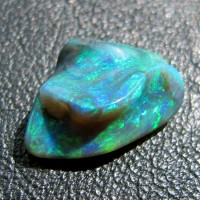
Wave Crest – Australian Boulder Opal 6.5 ct
I take into consideration how the opal can be incorporated into a piece of jewelry, whether the stone is best suited for a ring a pendant or an earring. On the MOHS scale, opals are relatively soft with a hardness of 5.5-6. Opals also contain 3%-10% water which makes them vulnerable to cracking or crazing so they are best stored in zip lock plastic bags or in a humidified environment. Rings tend to get considerable abuse, so unless I can create a setting that offers some protection for the stone, a pendant mounting is more practical. That said; I do make opal rings and they are very popular but an opal ring should be an occasional ring, not an everyday ring and always worn with care.
Most opals have one side or face that displays the most fire so I take this into initial consideration when I purchase a stone. How will I set it to maximize the play of fire of a particular stone? Many of the Mexican Fire Opals that I purchase are stunning from all directions. In this case, I try to create a setting that will showcase the opal from multiple sides.
Shopping for opals and other gemstones is not as simple today as it was years ago due to the many high tech enhancement processes that are currently used but with a little common sense and a good eye, choosing a good opal is not rocket science.
It’s important and relatively easy to determine if the stone is natural and untreated, synthetic or lab grown. The price will be an immediate clue and if the price is too cheap, there is probably good reason.
Lab grown opals are prevalent on the market and these opals are often gorgeous and fiery stones but usually with uniform pinpricks of fire throughout, and in a white or blue matrix. The play of color in a natural stone is random and more intriguing. The “Gilson” opal is a lab grown beauty that is ideal for inlay work and alive with iridescence, but the play of fire is uniform. Happily, most gemstone dealers are ethical and will disclose the providence of their stones. Unfortunately, once the manufactured inlayed rings get to “market,” they are often misrepresented as natural opal. I travel extensively and have observed this misrepresentation in tourist kiosks and cruise ship ports around the world.
The most common opal is the milky white Australian opal. Although there are some exceptional specimens, these opals tend to be pale in comparison to the Mexican fire opal or the Australian black or boulder opal. A typical, milky white Australian opal will have minimal specks of fire and is usually cut as a cabochon. These stones are most often set in traditional, uninspired mountings and flanked or encircled by small diamonds. You may have one of these, perhaps passed down from your mother or grandmother and although they are of sentimental value, unless the stone is exceptional, they are of little value to the collector. Unfortunately today, this common opal, although mined in Australia, is being shipped to China in mass quantities to be cut, treated, and set into jewelry.

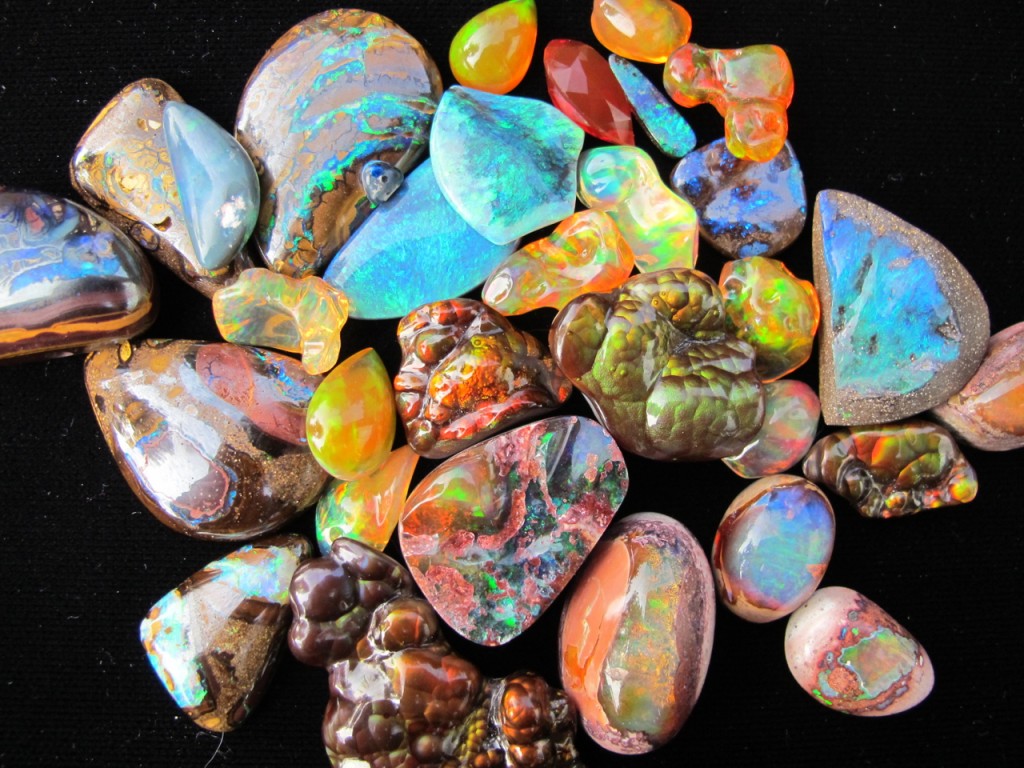
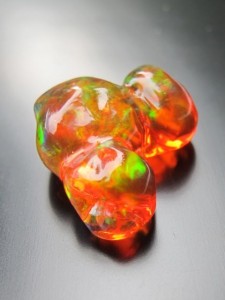
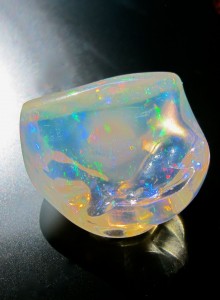

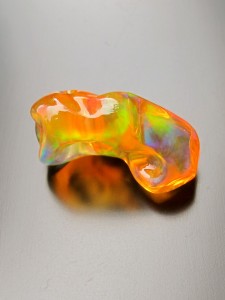
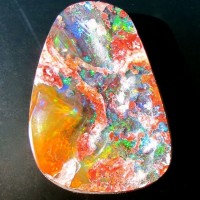
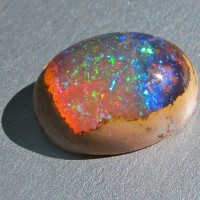
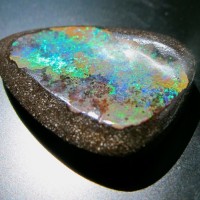
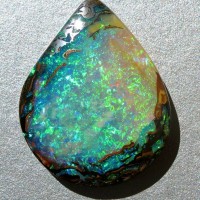
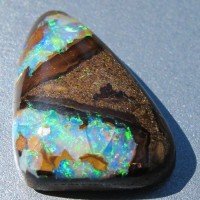
Hello! I’ve been searching on the Internet for Sunset Fire Opal rocks, particularly Mexican Sunset Fire Opal rocks, and several of your blog entries came up. The thing is, I read an article about these gorgeous rocks a couple of months ago, and I’ve been wanting to get one of these for a friend of mine that is very near and dear to me; he absolutely loves sunsets, which makes me look even harder for a Fire Opal rock that looks more like a sunset than anything else. I was wondering if you happened to know who I could contact, or where to find one online (that looks the way I want it to – a sunset) so that I may acquire a rock like this one? I’m a college student with not enough financial ability to go to these exhibitions, or go to Magdalena, Mexico, which, from my research, seems to be where the ones I’m specifically looking for are. If you could please help, I’d appreciate it greatly.
-Diana
Hi Diana, I’m not sure what you mean by a Sunset Fire Opal but I assume you mean an orange based Mexican Fire Opal. I have many available on my web site but the best ones are pricy. My only suggestion is to check out your local gem and mineral show events. There are gem and mineral shows in most major cities at least once a year. Aside from that, your best bet is looking at opal images online and connecting to the web site that sells them. Mexican Fire Opals are addicting! Good luck in finding the perfect stone. Marty
Hi Marty, I have a rough piece of what seems to be the Mexican Fire Opal with deep red bubbles that you have pictured above. It also shows color play with orange and yellow. Additionally, there is some light green transparent attached to the rough. I purchased this stone many years ago in Mexico without any knowledge of its character. It is about 4 inches by 3 inches estimated. I reside in California, and am wondering who you recommend I contact to evaluate the value and possibly cut and polish the stone. Also, if you would like to see photos of the stone, please provide me with an email address to send them. What is your opinion about the estimated value of a stone that size?
I like how you talked about finding fire agates for sale at gem and mineral shows! My wife loves collecting fine gems, and the fire agate ones are no exception. I’m going to have to start looking for a few shows we could go to and maybe find a fire agate for sale that she’s been dreaming about!